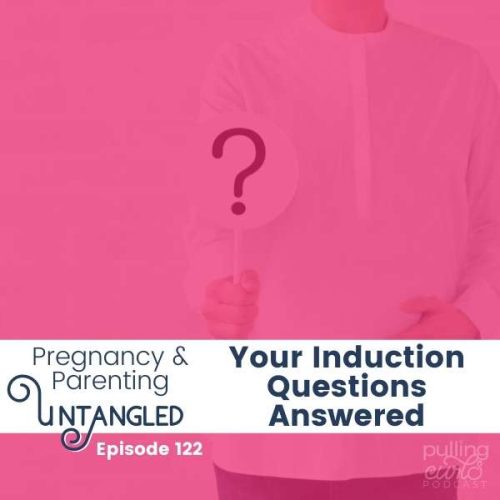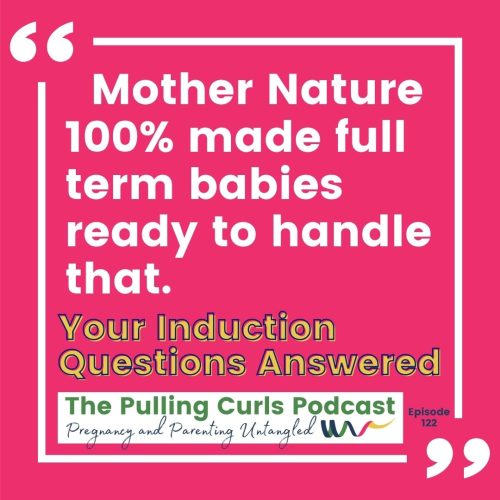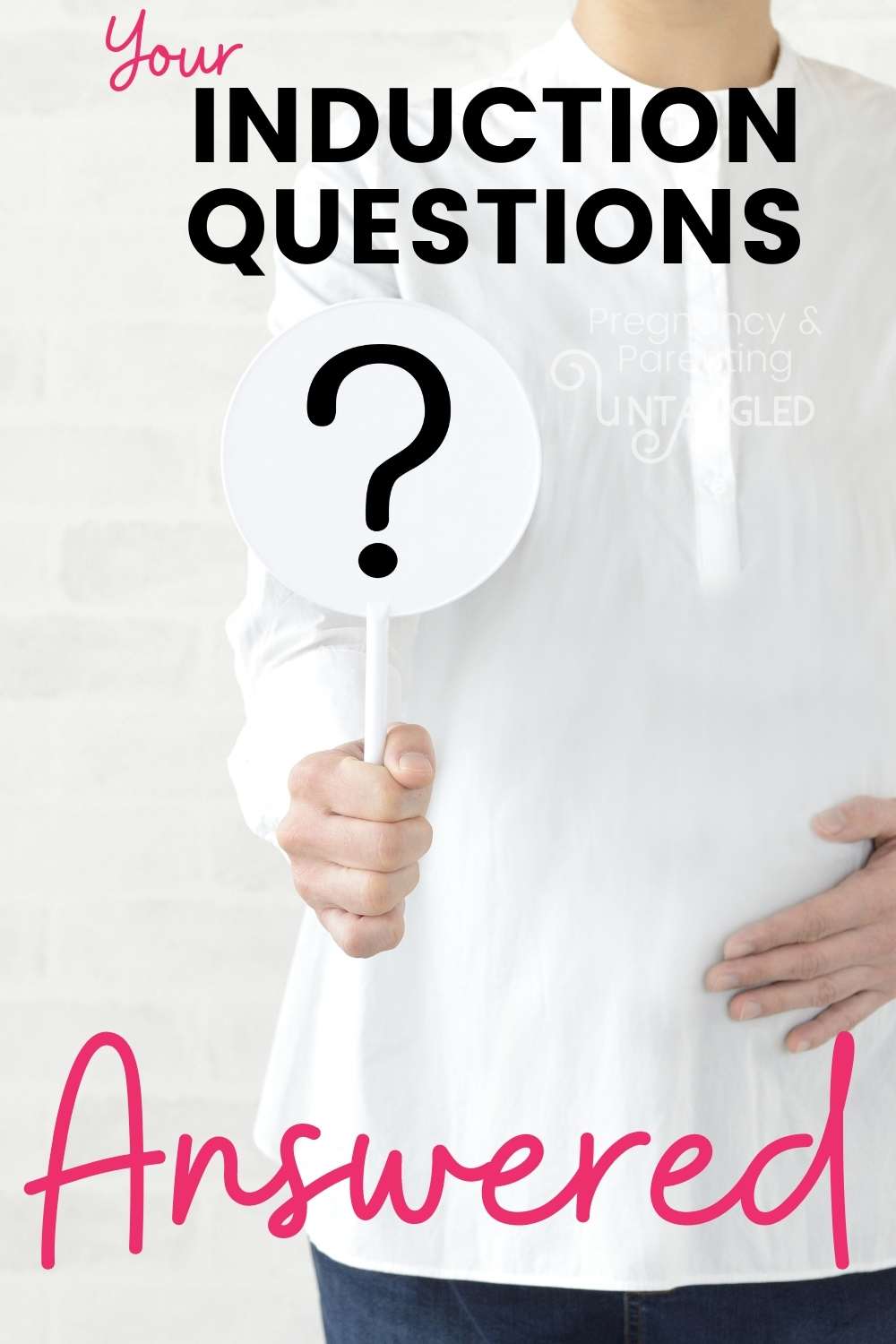
Today I’m taking YOUR induction questions and answering them to the best of my ability! What are the risks?
Check out all my induction info on the Pregnancy Nurse here: https://pregnurse.com/category/labor/induction/
Big thanks to our sponsor The Online Prenatal Class for Couples — if you’re looking to learn all the things about your delivery from beginning to end this is the course for you. In just three hours time you can prepare for your confident birth. It’s the class for you!
❤️🧡💛💚💙💜 I love, Love, LOVE that you’re here preparing — but I gotta ask if your partner is just as on board for how different things are going to be. If you’re thinking you’d like for you to BOTH get prepared I recommend this. Check it out!
In this episode
What are the risks of an induction?
Methods of Induction
Natural induction methods
Panic disorder during an induction — Here is my hypnobabies offer. My Therapy episode
Is an induction more painful
Is there more stress on the baby during an induction?
Other things that might interest you
Why Evidence Based Birth is Wrong
How Stress at Delivery Can Effect Your Baby
Husband Stitch and Other Myths
Producer: Drew Erickson
Check out my other pregnancy podcasts:
Looking to get prepare for your birth? I have some easy options for you!
~~~~~~~~
– Worried you’re missing something? Grab my pregnancy planner so you don’t miss a thing!
– Thinking about an induction? Grab Inductions Made Easy to feel prepared in just 20 minutes!
– Wondering how to get that baby OUT? Grab Going Into Labor Made Easy so you know how to (and not to) do it!
– Postpartum got you anxious? Check out Postpartum Care Made Easy so you can stay SAFE even when all your attention is on that little on.
🚨 AND if ALL OF IT has got you on edge The Online Prenatal Class for Couples is perfect for you — You’ll feel so ready before you even know it!
~~~~~~~~
No matter WHERE you are at in your pregnancy journey, we have resources that can help!

Transcript
[00:00:00.130] – Hilary Erickson
Hey, guys, welcome back to the Pulling Curls Podcast. Today on Episode 122, we are answering questions. Everything you want to know about inductions here on the Pulling Curls Podcast. Let’s untangle it.
[00:00:22.130] – Hilary Erickson
Hi, I’m Hilary Erickson, the curly head behind the Pulling Curls Podcast where we untangle pregnancy, parenting, home and even travel. We know there’s no right answer for every family, but hopefully we can spark some ideas that will work for yours. Life tangled just like my hair.
[00:00:45.270] – Hilary Erickson
Okay, guys, before we get started, let’s remember, I’m totally answering your question, so just drop a review. That would totally help me out. Thanks. Okay.
[00:00:53.370] – Hilary Erickson
So I asked on TikTok and Instagram for you guys’induction questions. I have a bunch here today. We’re just going to answer them. I’m going to be really honest. If I have no idea, we’re going to go from there.
[00:01:06.190] – Hilary Erickson
Do you feel prepared for your delivery? In just three short hours, you can be prepared for the confident, collaborative delivery you want, you’ll know what to expect and how to talk with your health care team. And there are no boring lessons in this class. I’ll use humor stories from my 20 years in the delivery room to engage both of you. I love how Alyssa told me that she found herself laughing at things that used to sound scary. Most of all you guys are going to be on the same page from Bump to Bassinette. Join the online prenatal class for couples today. You can save 15% with coupon code UNTANGLED. You can find the link in the show notes.
[00:01:41.930] – Hilary Erickson
All right, so first question, what are the risks of induction? Is there a higher chance of C section with an induction? So that being the main risk, induction does carry a higher chance of C section. Now you have to remember why if you’re looking at the whole spectrum of induction, there’s a lot of people who are getting induced who have very high risk pregnancies. That’s why we’re inducing them.
[00:02:00.710] – Hilary Erickson
And those people already have a higher chance of induction. So. Well, I think there is an overall increased risk. I’m not sure that it’s huge when you account for all those variables, but there is an increased risk. Now, that risk is mitigated.
[00:02:13.190] – Hilary Erickson
If your cervix is ready and we use something called the Bishop score, which counts for, like, how open it is, how soft it is if it’s anterior and posterior, which means if it’s forward or back, we’re kind of how easy it is for us to reach it. If it’s firm or soft, and we calculate all those into a number and if the number is higher, it means you have more favorable induction. That means your cervix is soft. It’s ready to be open. If it’s unfavorable, it means it’s like, hard, like a tire.
[00:02:37.610] – Hilary Erickson
We’re really going to have to work at it to get that baby out. Now, if you have preeclampsia and we really need to get that baby out. It doesn’t matter what your Bishop score is. We’re going to try and get that baby out. But if you’re just, like, 39 weeks and tired of being pregnant and your cervix is like a tire, that gives you an option to be like that is increasing my chance for a C section if I’m really trying to bust through something that’s not ready at all.
[00:03:00.110] – Hilary Erickson
So something to think about. But there is an increased risk of cesarean. It is an increased risk in general and labor just because we’re doing more things, there’s a chance of uterine rupture. There’s a chance when you have Pitocin going, there’s a greater chance of postpartum hemorrhage, which means you bleed after you have a baby. So there just are increased risk with an addiction versus just a natural thing.
[00:03:18.590] – Hilary Erickson
I mean, that’s the way most things are. There is an increased risk with an epidural versus, like, natural pain management. Okay, next question. Induction methods other than pit. So Pitocin and Arom, which is when we break your bag of water.
[00:03:30.830] – Hilary Erickson
And by “we” I mean your provider. I’m not allowed to break water. So there are several other methods. There are the medications that’s prostengel, cytotek, otherwise known as measlerostyl or Cervedil. And those are things that we stick into your body. Most of them go vaginally. Although cytotek can be done orally or stuck under your tongue. And those are just hormones that kind of start getting your cervix ready, and then usually we have to use Pitocin to get you going after that.
[00:03:57.290] – Hilary Erickson
Now you can also do a Foley bulb, and I have a whole video I’ll link to it in the show notes that kind of talks about the different ways that we can induce you a Foley bulb. You just think of it as like we’re blowing up a balloon inside your cervix, and so it’s just pushing on the edges. It’s more of a mechanical thing. It’s much more low risk, because if it doesn’t work, we just stop and you can still be pregnant for a while. So there you go.
[00:04:18.230] – Hilary Erickson
There are other methods, but once you hit about 3 cm, it’s mostly pitocin because the balloon can’t get you further than that, and the other ones can’t get you further than that. So there you go. Or just breaking your water.
[00:04:29.030] – Hilary Erickson
A lot of times people just come in and have their doctor break their water. So that’s a viable option also. Okay, next question, natural induction methods for people hoping to home birth or unmedicated birth. So I left this question in just to remind you guys that I literally have no idea about home birth, it is not an area of expertise for me. I would hope that people who are having a home birth are not somehow being induced, but I don’t even know as far as an unmedicated birth, I think she’s asking like, how can I go into labor without using medications?
[00:04:56.750] – Hilary Erickson
You can try the way that got you pregnant. You can try the mile circuit. There’s a lot of things you can do, but are they really going to put you into labor? Most likely not. A lot of people swear by Castor oil, but it is not safe for you or the baby.
[00:05:09.410] – Hilary Erickson
You are going to end up dehydrated and possibly the baby is going to poop inside the womb because they’re going to be stressed out too with their poor little tummies. And it’s just not good for anybody. So I guess my answer to that is I have no idea and no. Okay, how do you deal with panic disorder during an induction? So if you know you are going to be induced, I would definitely learn about the induction process if you have a lot of anxiety.
[00:05:32.510] – Hilary Erickson
And I think it’s really important for everyone to know that most people have a lot of anxiety when they think about going into the hospital and having things done for them. A lot of pregnant women have never been into the hospital for anything else and likely won’t be in the hospital anytime soon for anything other than having a baby. So it’s really normal to feel anxious and all those kinds of things. I would 100% recommend taking a class. I, of course, would recommend taking my class, but there’s lots of classes out there.
[00:05:56.990] – Hilary Erickson
Find someone that you identify with. If there’s something that you can pinpoint of a reason of panic, I would talk to your provider about that. If you have an issue of trauma and cervical exams are just really traumatic for you, talk with your provider, see how you can limit them, but also talk yourself through that the fact that they might be important. We can’t just do an induction and never really check your cervix unless it does really well and all of a sudden you’re in a great labor pattern.
[00:06:21.590] – Hilary Erickson
But a lot of times we’re having to see if what we’re doing is working, and there’s no really the only way to do that unless you’re actively contracting and the baby comes out is to check your cervix.
[00:06:31.130] – Hilary Erickson
So I would talk with your provider. I would get as much education as you can. And I would also do something like hypnosis to really help give you some methods of calming yourself down, because I have to say that birth is not the most stressful thing that I have done with my children. Potty training wasn’t very fun and teaching them how to drive has trumped all of them. So learning how to deal with your own emotions is going to serve you so well as a mom.
[00:06:53.030] – Hilary Erickson
So I love Hypno Babies, and I in fact, give my class at 50% off if you purchase hip no babies as well. I will put the link in the show notes. If you go to pullingcurls.com and you type in Hypno Babies offer it should pop up also. So what you do there is you purchase Hypno Babies. And then I give you a coupon code for half off of my class.
[00:07:08.990] – Hilary Erickson
You have to use my link in order to purchase Hypno Babies. It’s pretty snazzy. I would recommend that very much. I would definitely be seeing a therapist.
[00:07:15.650] – Hilary Erickson
I would not just rely on medications, see with somebody so that they can help you through see my therapy episode. I found it extremely helpful, and I did it online, so really easy. Okay. Next question. Our induction is more painful.
[00:07:27.410] – Hilary Erickson
This is actually something that I brought up in one of my induction myths posts. And I see a lot of people saying inductions are way more painful. I think that most people receive inductions as way more painful because you’re stuck in the hospital all the time. Like when you’re at home and you’re in labor, you’re like, I think I’ll make some brownies. And so you make some brownies, and then you have a nap, and then you drink some water, and then your husband brings you take out that you love, and then you walk around, and then you watch one of your favorite shows.
[00:07:50.930] – Hilary Erickson
And then he rubs your back and you’re not feeling all that great. But you’re able to move do all the things that you want to do versus an induction. You’re stuck in our bed. You’re stuck with our monitor, you’re stuck with our crappy food. It’s an unknown place.
[00:08:03.230] – Hilary Erickson
There’s no making brownies at the hospital, which is a real bummer. It’s just all those different kinds of things. So there is no way to measure pain. All we can do is ask you how much pain it is. And most women do find an induction more painful just because we’re pushing those contractions on.
[00:08:18.110] – Hilary Erickson
Now, a lot of providers really want us to push pitocin hard. So every hospital has a strict policy and procedure. Ours was you can go up 2 million units every half an hour. So every half an hour you’d go in there. There were doctors that would call me and see what number I was on.
[00:08:32.270] – Hilary Erickson
And they would do the calculations on their own. And they’d be like, you should be up to twelve by now, and I’d be like, yeah, but we had a half an hour where it wasn’t increasing. Sometimes they watch you that hard if you’re like, you know what? I feel like. The contractions are really great right now.
[00:08:44.150] – Hilary Erickson
They’re every three minutes. That’s what I personally am aiming for. I don’t want you to increase the pitocin anymore. Say that at the same point in time, we’re also going to want to make sure that those contractions are opening your cervix, because if you’re there for an induction, we want to make sure that it’s working. So that’s something to consider as well.
[00:09:01.430] – Hilary Erickson
But some doctors want to see those contractions every two minutes. And if you are trying for a natural birth, that is very difficult. You don’t have any time to rest and rejuvenate. And there actually is a study that said for most women, especially if your term and you had a favorable cervix when you get to five or 6 CM, they can turn off the pitocin. And most often your body will just continue to labor as it has.
[00:09:24.950] – Hilary Erickson
That’s something to think about as well. I kind of got off tangent. Our induction is more painful. It’s impossible to measure pain. Most women perceive them as more painful, but I personally think as someone who’s been induced, that laboring at home is just way more often until I don’t want to deliver the baby at home. What I always wanted to do was get to the hospital at 6 cm. Never did it.
[00:09:46.610] – Hilary Erickson
Okay. Last question is there more stress on the baby during an induction? There definitely can be. And that is why we use continuous fetal monitoring to make sure how baby is tolerating the contractions. When your uterus contracts, less blood gets to the baby because you’ve got to think if you clenched your fist really hard right now, see how your knuckles get really white. Your uterus is kind of the same way, and the placenta just doesn’t get a whole lot of blood flow because it’s contracting. And so when the baby’s not getting all that awesome blood flow, it does put stress on them. Now.
[00:10:16.310] – Hilary Erickson
Good news. Mother Nature 100% made a full term babies totally ready to handle that. They gave them extra ways to get oxygen in their blood and they have all these reserves through the placenta and everything else that they are really prepared to have. Those moments where oxygenation is just not so awesome. However, like I was talking about before, if a provider really wants to see those contractions like every two minutes, they really are stepping away from that.
[00:10:41.270] – Hilary Erickson
I feel like, by the way, BTW. But back in the day I had many providers who wanted a contraction every two minutes and usually contraction’s 1 minute long, so that would maybe give you 1 minute between contractions, which is really what you’re aiming for. But I like to see 90 seconds between contractions to really give mom and baby sometime to just chill out before the next one comes so that can cause more stress on the baby. But however, delivery in general does cause the baby some stress.
[00:11:07.490] – Hilary Erickson
They’re moving a little bit more.
[00:11:08.630] – Hilary Erickson
The cord is slipping and sliding all over the place. So there is some increased stress to the baby. Obviously, that’s part of the risk for an induction. If we push too hard, a baby doesn’t look very good, then they would need to do a C section. But in general, especially when you start with like, cytok misoprostyl serverdale babies handle those pretty darn well, and then hopefully we won’t have to go too hard on the Pitocin before as we induce you.
[00:11:32.030] – Hilary Erickson
So those are my thoughts on an induction I am a big believer of trying to let Mother Nature take her course. I went twelve days over with my last one, and I cried when I had to get induced, but by the way, it was totally fine, and I was being super dramatic, and I’m a little bit embarrassed about how I acted back then. But if you can let Mother Nature take her course, it is safer. It is easier. It’s better for your body.
[00:11:52.850] – Hilary Erickson
But a lot of times, Mother Nature just isn’t in the mood to get the baby out or is not in the mood to get the baby out because you’re early and you have preclampsia or diabetes or all those different kinds of things. So lots of people end up getting induced. I want you to tell me what other questions you have about inductions over on Instagram with a post about this, and I’d love for us to have a discussion over there as well.
[00:12:11.990] – Hilary Erickson
Do not miss next week’s episode. I saw a TikTok that you weren’t supposed to pee in the shower, and I didn’t really understand it, so I’m having my favorite physical therapist come back on and we’re talking about it there. It’s more than just not peeing in the shower, so definitely stay tuned.
[00:12:25.910] – Hilary Erickson
Thanks so much for joining us on today’s episode. We know you have lots of options for your ears, and we are glad that you chose us. We drop episodes weekly, and until next time, we hope you have a tangle free day.






Leave a Reply